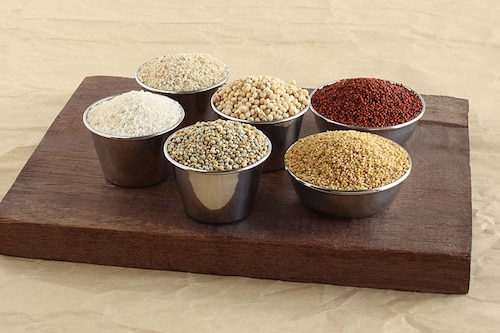Why India should lead the millet revolution
Millet revolution is closely linked to a more sustainable, responsible, and healthier future and India, which contributes to 20 percent of the world's total millet production, can speedily propel the


Millets were a staple food in India till a few decades ago. The Green Revolution in the 1960s and the distribution of wheat and rice in the Public Distribution System (PDS) thereafter moved the humble millets away from the Indian kitchen. However, in recent times, the discourse on climate-smart agriculture has moved the focus back onto millets.
Significantly, millets have been closely linked with the attainment of many significant United Nations’ Sustainable Development Goals (SDGs)—primarily, SDG 2 (Zero Hunger), SDG3 (Good Health and Well-being), SDG 12 (Sustainable Consumption and Production), and SDG 13 (Climate Action).
Millets are prolific—20 varieties of millets are grown in 130+ countries. India has Jowar (Sorghum), Bajra (Pearl millet), and Ragi (Finger Millet). Millets are hardy and resilient crops that grow in severe weather conditions, like drought and extreme temperatures. In a world where soil erosion and degraded soil quality are now commonplace, millets hold great promise as they can grow in low-fertility soil. Millets enhance soil quality over time, since they aggregate nutrients, and their fibrous root network helps preserve soil.
The clincher is that they need only about one-third the water required to grow other staple crops like rice and wheat—this is a huge agronomic positive, in an increasingly water-challenged world. A bonus is that they hardly require fertilizers and pesticides, allowing easy crop maintenance.
For a world grappling with climate change, as a C4 category cereal, millets absorb and convert substantial carbon dioxide to oxygen, combatting climate change linked to carbon emissions.
Conducive to millet cultivation, due to dry soil conditions and low moisture, households in Rajasthan grow and consume “bajre ki roti", with dollops of ghee. India contributes to 20 percent of the world’s total millet production, of which the acres of millet fields in the backdrop of the rugged Aravallis help Rajasthan record 29 percent of Indian production, followed by Maharashtra (15 percent), and UP (14 percent).
Recent research at ICAR’s Indian Institute of Millets Research (IIMR) has confirmed the knowledge of our ancestors: Millets are a nutritional powerhouse, packing an array of powerful health benefits (often, they are referred to as ‘nutri-cereals’). They contain thrice the fibre as wheat and ten times more than rice. Due to their low glycaemic index, they help in regulating blood sugar which is great for diabetics. They are also completely gluten-free and provide a perfect low-cost option for those seeking this benefit. Millets are rich in zinc, calcium and protein, making them an ideal alternative for vegetarians and those seeking more plant-based foods in their diet.
Most important, they are a fantastic source of iron, and several studies have proven their effectiveness in alleviating anaemia. Research by the International Crops Research Institute of the Semi-Arid Tropics (ICRISAT) revealed that children fed millet-based meals showed notably better growth compared to those who were not (28.2 percent increase in height, and a 37 percent increase in chest circumference).
Millets are also slowly making a comeback on the shelves of Indian supermarkets in riveting forms and flavour avatars. Brands like ‘Tru Millets’, ‘Slurrp Farm’, ‘GoodDiet’, ‘Trinch’ and ‘Millets for Health’ (the last two are featured here) are incorporating millets into pancakes, energy bars, noodles, and in Ready-to-Eat format to appeal to the modern palette (many also use the Direct-to-Customer route to reach the customer).
The Government of India has also recognised the importance of promoting millets, and pushed the UN General Assembly to designate 2023 as the "International Year of Millets". The Indian External Affairs Minister said that “a concentrated global push for millets is needed as three Cs—Climate change, Covid, and Conflict—were impacting food security in some way or the other".
While millets are being recognised as superfoods in every sense, their adoption can only gain momentum through the provision of larger incentives, for every section of society. By including millets in PDS, households in India will have access to a portion of food that fulfils complex dietary requirements. The judicious addition of millet in the mid-day meal scheme in government schools will be a great opportunity to ensure that nutritional needs are met early.
Much of the success of the millet revolution depends on farmers and their willingness to grow millet. Government subsidies, incentives, and dedicated online and offline marketplaces can encourage more farmers to join the cause. Partnerships with NGOs and agri-tech startups can further the twin goals of awareness and technological advancement, making millets more ‘citizen-demanded’, and profitable.
In conclusion, there is no doubt that the millet revolution is closely linked to a more sustainable, responsible, and healthier future.
The jury is out on whether India can speedily propel the humble superfood to solve the growing problems of climate change, water shortage and systemic injustices in food security.
Mr Prabhat Pani, (Executive Director, Centre for Innovation in Sustainable Development) and Akshita Agrawal (PGDM, SPJIMR)
First Published: May 23, 2023, 13:19
Subscribe Now